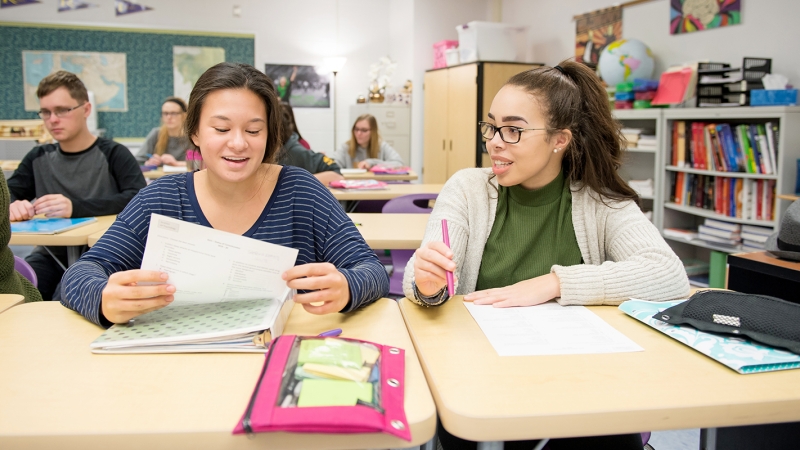
Dyslexia Handbook: Glossary of Terms
Definitions of terms found in the Dyslexia Handbook
accommodations: practices, supports, or services provided to help a student access the curriculum and validly demonstrate learning. Accommodations are provided to support equitable access during instruction and assessments for students with disabilities, and intended to lessen the impact of the student’s disability on his or her educational achievement. Accommodations are individualized and based on a student’s needs.
accuracy: reading the words in a selection correctly.
assistive technology: any item, equipment or system used to increase, maintain, or improve the functional capabilities of people with disabilities.
attention-deficit/hyperactivity disorder: a brain disorder marked by an ongoing pattern of inattention and/or hyperactivity-impulsivity that interferes with functioning or development.
automaticity: fast, effortless word recognition.
co-existing or comorbid conditions: two or more conditions that exist simultaneously.
compensatory strategies: activities that promote the acquisition of reflective cognitive learning styles. Using strengths as a reader to compensate for weaknesses.
core instruction: another term for classroom instruction, serves as the common center of instruction for all students, provides students with opportunities to apply taught strategies to authentic meaning-making experiences.
cumulative: any skill or strategy continuously applied with increasing complexity.
decodable texts: a type of text often used in beginning reading instruction which includes words readers can pronounce using the phonics skills they have been taught.
decoding: the ability to apply knowledge of letter-sound relationships, including knowledge of letter patterns, to correctly pronounce written words.
diagnostic assessment: an assessment often administered one-on-one, focused gathering information about selected areas or domain of knowledge. It can provide educators with information about student needs in order to plan tailored instruction or intervention.
differentiated instruction: an approach to teaching that provides different avenues for learning in terms of varying the content, process, and product based on a student's readiness, interest and learning profile.
direct instruction: teaching skills in an explicit manner through a gradual release of instruction.
double-deficit hypothesis: a hypothesis presented by Dr. Maryanne Wolf of Tufts University that dyslexia can stem from a single deficit in phoneme awareness or naming speed or in both.
dyscalculia: a mathematical disability in which a person has unexpected difficulty solving arithmetic problems and grasping math concepts, such as time, measurement, and spatial reasoning, as defined by the International Dyslexia Association (IDA).
dysgraphia: a learning disability that affects writing abilities and can manifest itself as difficulties with spelling, poor handwriting and trouble putting thoughts on paper, as defined by the IDA.
dyslexia: a specific learning disability that is neurobiological in origin. It is characterized by difficulties with accurate and/ or fluent word recognition and by poor spelling and decoding abilities. These difficulties typically result from a deficit in the phonological component of language that is often unexpected in relation to other cognitive abilities and the provision of effective classroom instruction. Secondary consequences may include problems in reading comprehension and reduced reading experience that can impede growth of vocabulary and background knowledge, as defined by the IDA.
evidence-based: effective educational strategies supported by evidence and research, as defined by the Elementary and Secondary Education Act of 2002.
executive functioning: a set of processes that have to do with managing oneself and one's resources in order to achieve a goal (includes neurologically-based skills involving mental control and self-regulation).
explicit: stated clearly and in detail, leaving no room for confusion or doubt.
fidelity: the delivery of practices and programs in the way in which they were designed and intended to be delivered, accurately and consistently with a high level of quality.
fluency: the ability to read text accurately with sufficient pacing, phrasing, and expression so that deep comprehension is possible.
fluent word recognition: the ability to read words accurately with sufficient pacing.
growth mindset: the belief that the most basic abilities of an individual can be developed through dedication and hard work--brains and talent are just a starting point.
immediate corrective feedback: the practice of providing a student with formal or informal feedback on his or her performance.
Individuals with Disabilities Education Act (IDEA): a federal law that requires schools to serve the education needs of eligible students with disabilities in the least restrictive environment through an individualized education program reasonably calculated to enable the student to make progress appropriate in light of the student’s circumstances.
Interventions: evidence-based, systematic, and explicit instruction that targets a specific area of need. It is provided in addition to core instruction and is intentionally designed to increase performance in relation to a specific, measureable goal. Interventions must be based on valid and current performance data, delivered with fidelity, and require ongoing progress monitoring.
language comprehension: the ability to correctly process word and phrase meanings, sentence grammar, and discourse or text structure.
letter recognition: the ability to visually recognize letters of the alphabet.
letter-sound recognition: the ability to identify the sound or sounds each letter makes.
multisensory: a teaching technique that uses more than one sense (e.g., auditory, visual, tactile, and kinesthetic) to help a student learn.
neurobiological disorder: an illness of the nervous system caused by genetic, metabolic, or other biological factors.
Orton-Gillingham approach: a methodology used to develop accuracy and fluency in reading and spelling. The Orton-Gillingham principles of effective phonics instruction for students with dyslexia uses direct, explicit, systematic, sequential instruction that is multisensory in nature; provides cumulative review; and includes immediate, corrective feedback.
phonemic awareness: a subset of phonological awareness in which listeners are able to hear, identify and manipulate phonemes, the smallest units of sound that differentiate meaning. Separating the spoken word "cat" into three distinct phonemes, /k/, /a/, and /t/, requires phonemic awareness.
phonics: a reading method that directly teaches the relationships between the sounds and letters of an alphabetic writing system.
phonological: system of a language includes an inventory of sounds and their features, and rules which specify how sounds interact with each other.
phonological awareness: a variety of activities demonstrating an awareness of the structure of spoken words, including segmenting (or breaking apart), blending (or putting together), and manipulating (or changing) the spoken syllables and sounds in words.
processing disorder: a deficiency in a person’s ability to effectively use the information gathered by the senses. The issue is not the result of impaired hearing, impaired vision, attention disorders, or an intellectual disability.
rapid automatized naming: a task that measures how quickly individuals can name aloud objects, colors, or symbols (letters or digits).
reading comprehension: the ability to understand what one is reading.
remediation: The act of remedying an area of instructional need for a student (e.g., teaching a student how to blend speech sounds together to pronounce a word).
Responsive Instruction (RI): a multi-tiered system of support (MTSS) through which teams make instructional decisions based on data in order to provide differentiated classroom instruction and the necessary academic, behavior, and student wellness supports for all students across all schools.
secondary consequences of dyslexia: may include difficulties in reading comprehension and/or written expression. May also include social emotional impact.
self-advocacy: when a student understands his or her own strengths and weaknesses, knows what is needed to succeed, and communicates these needs with other people.
specially designed instruction: as defined in IDEA, adapting, as appropriate, the content, methodology or delivery of instruction to address the unique needs of the student that result from the student’s disability; and to ensure access of the student to the general curriculum.
specific learning disability: As defined by 34 CFR 300.8(c) (10), a disorder in one or more of the basic psychological processes involved in understanding or in using language, spoken or written, that may manifest itself in the imperfect ability to listen, think, speak, read, write, spell or to do mathematical calculations, including conditions such as perceptual disabilities, brain injury, minimal brain dysfunction, dyslexia, and developmental aphasia. Specific learning disability does not include learning problems that are primarily the result of visual, hearing, or motor disabilities; of intellectual disabilities; of emotional disabilities; of environmental, cultural, or economic disadvantage (see also § 22.1-213 of the Code of Virginia).
spelling: the process of writing the letters of a word in their precise sequence according to accepted usage.
structured literacy program: instruction that explicitly focuses on systematic word-
identification/decoding strategies, is systematic and cumulative, explicit, and diagnostic.
systematic and sequential: step by step in a predetermined order.
twice-exceptional: refers to intellectually gifted students who have some form of disability and are considered exceptional both because of their intellectual gifts and their special needs.
word recognition: the ability of a reader to recognize written words correctly and virtually effortlessly.
working memory: the preservation of information while processing the same or different information; tasks often require transforming the information in some way.
writing composition: using complete sentences to express thoughts or ideas on paper.
© 2017 Fairfax County School Board. All rights reserved. This material may not be reproduced, displayed, modified or distributed without the express prior written permission of the copyright holder. For permission, contact the FCPS Department of Special Services, Office of Special Education Instruction, Willow Oaks Corporate Center, 8270 Willow Oaks Corporate Drive, Fairfax, VA 22031.





